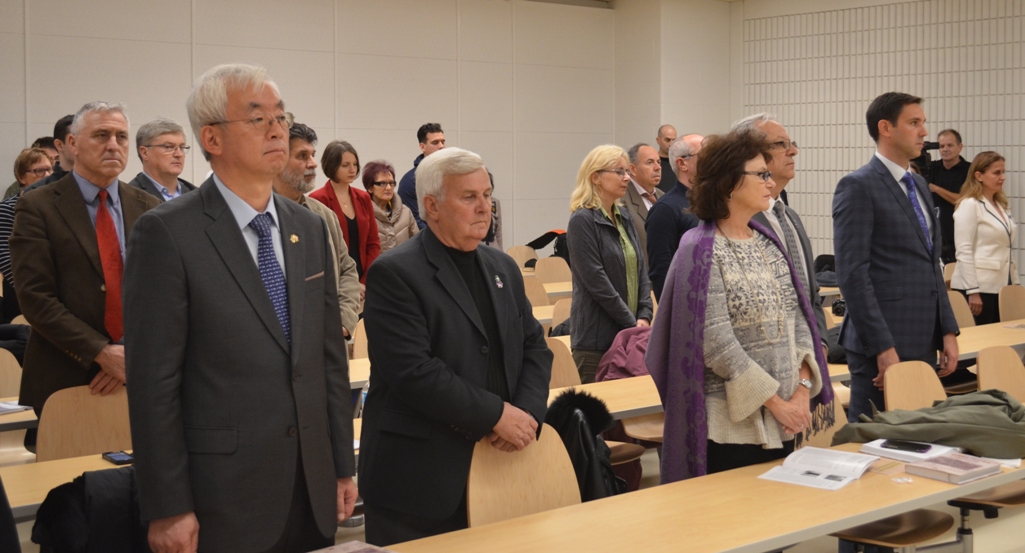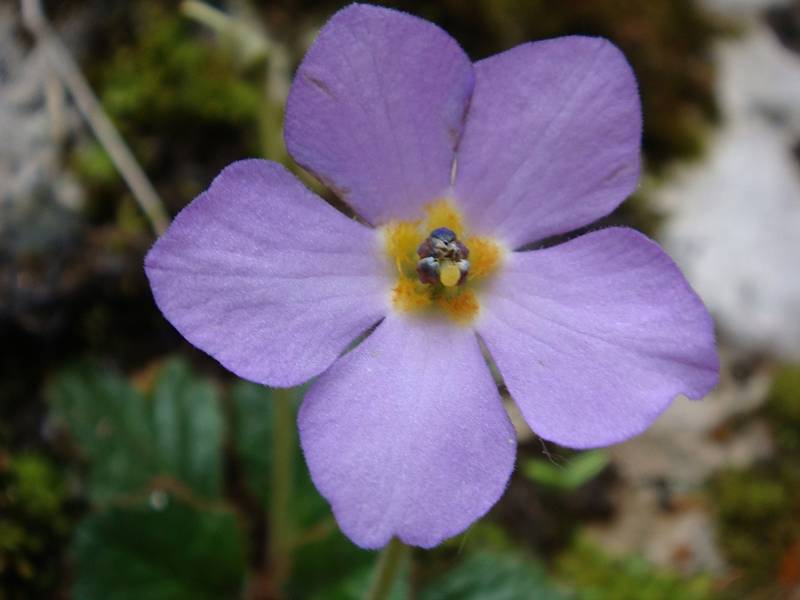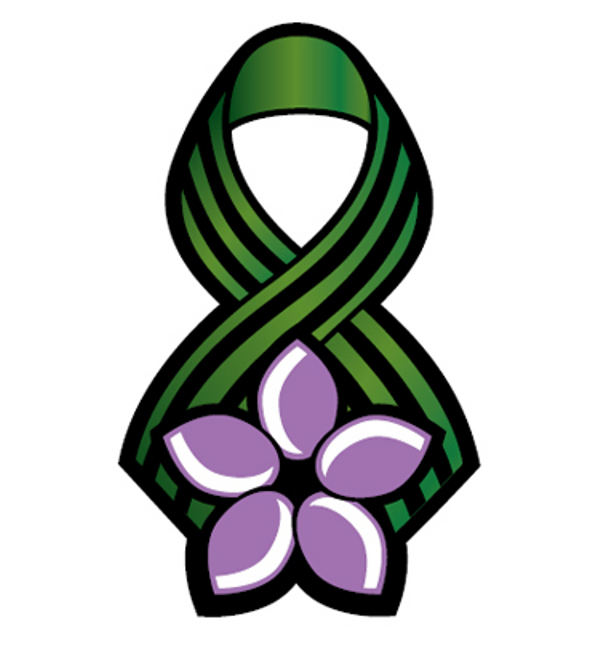Left: Serbian Consul General V. Petkovic opening photo exhibit at the lobby of the Faculty of Medical Science in Toronto; Right: Cheirman o f the Board of the Serbian Heritage Academy of Canada Mr. Zarko Brestovac and Serbian Consul General V. Petkovic lieng wreath bellow the Memorial plaque dedicated to the members of the Canadian Medical Corps engaded in Serbia and Balkan front during WWI.

Part of the participants at the Lecturing about Canadian Medical Missions in Serbia and Balkan war during WWI (front row: CG of R. Korea, CG of Moldova, CG of Hungary, CG of Greece; Behind: CG of Austria, representative of CG of RF, ret. Head of Military-Police Academy of the Canadian Armed Froces etc.).
Left: Serbian Consul General V. Petkovic during his introductionray speech at the Lecturing; Right: On behalf of the Serbian Heritage Academy of Canada, Phd. Mr. Rajko Rey Radojevic, professor of history during his speech at the classroom of the Faculty of the Medical Science of the Toronto Unviersity.
ON THE OCASSION OF THE COMMEMORATING OF THE ARMISTICE
IN THE FIRST WORLD WAR
The Commemoration of the 100th anniversary of the Armistice in the First World War entitled "The Canadian Medical Mission in Serbia and on the Balkan Front in the First World War" was held on November 7, 2018 at the Faculty of Medical Science of the Toronto University, organized by the Consulate General of the Republic of Serbia in Toronto and the "Serbian Heritage Academy of Canada". As a part of the Commemoration, a thematic lecturing and an exhibition of war photographies were organized as well.
The Commemoration was attended by representatives of the Canadian Veterans Associations, members of the Consular Corps, representatives of the Canadian SPC Diocese, prominent members of the Serbian Diaspora, professors and students from Toronto University, York University, Ryerson University and other guests.
On behalf of the Government of the Republic of Serbia and the Consulate General, Consul General Vasilije Petkovic laid a wreath in front of a memorial plaque dedicated to the members of the Canadian Medical Corps. The plaque has been set up by the Serbian Heritage Academy of Canada in the 80`s of the 20th century in Memorial hall of the Toronto University`s Faculty of Medicine, for their valor and contribution to the Allied victory on the Thessalonica front, treating Serb civilians and Serbian and allied soldiers. Among Canadian volunteers was Lester Pierson, late Prime Minister of Canada in a period from 1963 to 1968, who was the winner of the Nobel Peace Prize in 1957 for the establishment of the UN military peacekeeping force.
In his introduction speech, Consul General of the Republic of Serbia in Toronto Vasilije Petkovic, pointed out a historical link between the Serbian and Canadian people and casts light on the participation of Canadian volunteers in the medical corps at the Thessaloniki front. These brave and humane women and men, as well as one of the most important Canadian figures, in their history, late Prime Minister Lester Pierson, left Canada and their comfortable life, either upon call of duty or voluntarily in order to come in a war-affected Serbia and together with the wounded, hungry, lacking medicines and medical devices, passed through the Albanian Golgotha participating in their own way at the Thessalonica front. Most of them happily survived horrors of the WWI, but some, unfortunately, did not survive, either killed in action or passed away suffering from diseases and infections, the same ones they were treating Serbian soldiers from.
Consul General Vasilije Petković pointed out the fact that most Canadians, unfortunately, are not aware of the historical and the great humanity of their fellow citizens and ancestors in Serbia during the First World War, but that the Serbs in Serbia and Canada, as well as the state of Serbia, did not forget their offered hand and help, when it was most needed. The Serbian Heritage Academy of Canada also set up a memorial plaque at the Museum of the Serbian Medical Society in Belgrade, on which is written bilingually in English and French: ``Thank you Canadians/Mercies Canadian``, the inscription that speaks enough for its self.
At the end of his introduction speech, Consul General Vasilije Petković presented to the audience flower "Ramonda Serbica" or "Ramonda Nathaliae" informing them about the history and significance of the flower, as a symbol of the rebirth and resurrection of the Serbian army after the tremendous efforts, passing through the Albanian Golgotha and the glorious breakthrough at the Thessalonica front in World War I.
On behalf of the "Serbian Heritage Academy of Canada" PhD. Rajko Rej Radojevic (living and working in Canada for more than 50 years) gave a comprehensive lecturing on the topic of Serbian participation and contributions in the First World War as well as the participation of the Canadian medical corps on the Thessaloniki front. He presented historically available, proven and confirmed data on names and biographies before, during and after the Great War of all Canadian volunteers within the medical corps.
After the lecture, the guests visited the photo exhibition dedicated to the Canadian medical corps members and their activities at the Thessalonica front, including photo of late Canadian Prime Minister Lester Pierson.
A catalog with a short overview of the lecture and exhibition with photographs was presented to all visitors, and in addition, a VIP guests were given a book ``Serbia 1914-1918, a Gallant Ally``,
along with the badge of the flower "Ramonda Serbica".
Ramonda Serbica or Ramonda Nathaliae


Also known as Serbian Ramonda and Serbian phoenix flower, is a species in the Gesneriaceae family. It is one of the few European representatives of this family, found in Southeast Europe - Southern Balkans. The flower was discovered near city of Niš (Nish) in Serbia in 1874 by Serbian botanist Josif Pančić and scientifically described in 1884 by Sava Petrović, well known Serbian medical doctor at that time. The flower Ramonda Serbica is known for its ability to be revived when watered, even when fully dehydrated.
Therefore the flower is considered as a symbol of the Serbian Army's struggle and resurrection after devastating retreat over the Albanian mountains to Greece, during World War I. By wearing Ramonda Serbica, we honour and commemorate Serbian and Allied victims and Armistice Day in the WWI, which have the same meaning like wearing the British Remembrance Day Poppy flower.
The other name Ramonda nathaliae was given after Serbian queen Natalija Obrenovic, who was queen of Serbia from 1882 to 1889 as wife of king Milan I Obrenovic.
The Green and black background of Ramonda Serbica represents the Colours of the Commemoration Medal of the Retreat trough Albania assigned to the soldiers participated in the Great War.